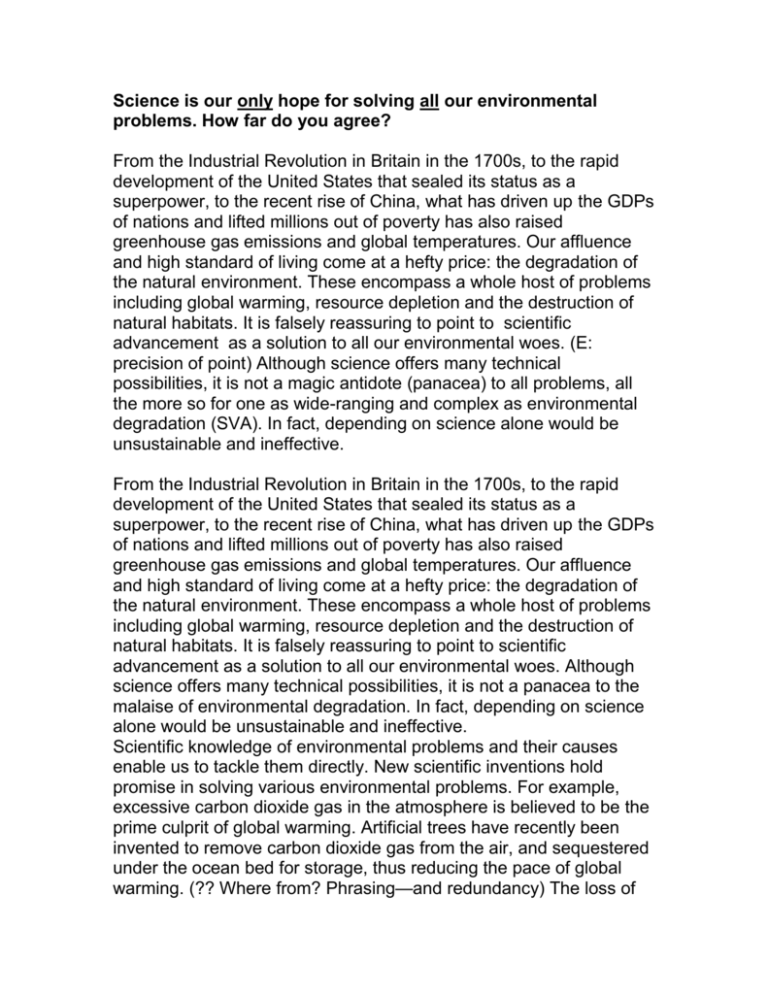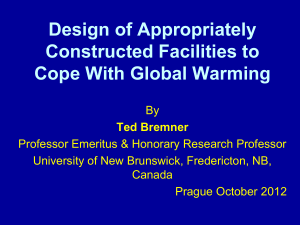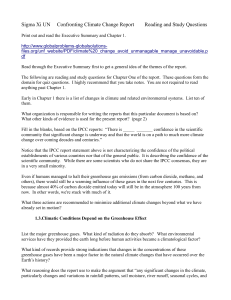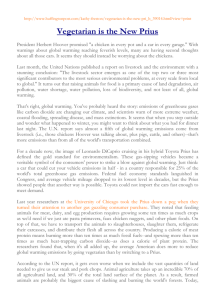Science is our only hope for solving all our environmental
advertisement

Science is our only hope for solving all our environmental problems. How far do you agree? From the Industrial Revolution in Britain in the 1700s, to the rapid development of the United States that sealed its status as a superpower, to the recent rise of China, what has driven up the GDPs of nations and lifted millions out of poverty has also raised greenhouse gas emissions and global temperatures. Our affluence and high standard of living come at a hefty price: the degradation of the natural environment. These encompass a whole host of problems including global warming, resource depletion and the destruction of natural habitats. It is falsely reassuring to point to scientific advancement as a solution to all our environmental woes. (E: precision of point) Although science offers many technical possibilities, it is not a magic antidote (panacea) to all problems, all the more so for one as wide-ranging and complex as environmental degradation (SVA). In fact, depending on science alone would be unsustainable and ineffective. From the Industrial Revolution in Britain in the 1700s, to the rapid development of the United States that sealed its status as a superpower, to the recent rise of China, what has driven up the GDPs of nations and lifted millions out of poverty has also raised greenhouse gas emissions and global temperatures. Our affluence and high standard of living come at a hefty price: the degradation of the natural environment. These encompass a whole host of problems including global warming, resource depletion and the destruction of natural habitats. It is falsely reassuring to point to scientific advancement as a solution to all our environmental woes. Although science offers many technical possibilities, it is not a panacea to the malaise of environmental degradation. In fact, depending on science alone would be unsustainable and ineffective. Scientific knowledge of environmental problems and their causes enable us to tackle them directly. New scientific inventions hold promise in solving various environmental problems. For example, excessive carbon dioxide gas in the atmosphere is believed to be the prime culprit of global warming. Artificial trees have recently been invented to remove carbon dioxide gas from the air, and sequestered under the ocean bed for storage, thus reducing the pace of global warming. (?? Where from? Phrasing—and redundancy) The loss of rich ocean biodiversity due to the death of coral reefs from sea temperature rising can be mitigated by recent coral reef development technologies. These stimulate coral growth at an accelerated pace, which attracts ocean wildlife back to restore biodiversity. Such methods are specific to each environmental problem; hence by using science to develop a solution to each and every one of them, they can be tackled relatively effectively. Scientific knowledge of environmental problems and their causes enable us to mitigate the negative effects that already exist. New scientific inventions hold promise in solving various environmental problems. For example, excessive carbon dioxide gas in the atmosphere is believed to be the prime culprit of global warming. To solve this, artificial trees have recently been invented to remove carbon dioxide gas from the air. This greenhouse gas is then sequestered under the ocean bed, thus reducing the overall amount of carbon dioxide in the atmosphere. Also, the loss of rich ocean biodiversity due to the death of coral reefs from sea temperature rising can be mitigated by recent coral reef development technologies. These stimulate coral growth at an accelerated pace, which attracts ocean wildlife back to restore biodiversity. Such methods are specific to each environmental problem; hence by using science to develop a solution to each and every one of them, they can be mitigated to a certain extent. Scientific methods can also be used to identify the causes of environmental problems, and tackle them at the root. (how is this different from para above?) Transportation is a major source of energy consumption all over the world, typically contributing to a quarter of total pollutant emissions. These lead to greenhouse gas production, acid rains, and ultimately contribute to global warming. By installing catalytic converters in all vehicles, heavily polluting carbon monoxide and nitrogen oxides can be removed from the exhaust before releasing less harmful products into the air. Such technologies tackle each environmental problem at its root, in this case preventing the polluting gases from being released into the atmosphere in the first place. Hence science can provide solutions to address the underlying cause of environmental problems. (thesis appears same as para above: redundancy. Clarify pt precisely). Apart from mitigation, science can also be used to identify the causes of environmental problems, and tackle them at the root. Transportation is a major source of energy consumption all over the world, typically contributing to a quarter of total pollutant emissions. These lead to greenhouse gas production, acid rains, and ultimately contribute to global warming. By installing catalytic converters in all vehicles, heavily polluting carbon monoxide and nitrogen oxides can be removed from the exhaust before releasing less harmful products into the air. Such technologies tackle each environmental problem at its source, in this case preventing the polluting gases from being released into the atmosphere in the first place. Hence science can directly address the underlying cause of environmental problems. However, no matter how capable our scientific knowledge and techniques are, science cannot be our only weapon against such a formidable enemy. (what enemy? Clarity.) To be overly dependent on science is not only costly, but more importantly, is unsustainable in the long run. (prove. Sweeping). Strong political will on the part of governments are (SVA) also needed to effectively tackle environmental problems. Environmental policies can be enforced both at the international and national levels. The Kyoto protocol, an international environmental treaty to reduce carbon emissions, is signed and ratified by most countries in the world. (p) Though not legally-binding, participating countries are obliged to reduce their carbon emissions to pre-1990 levels, thus reducing greenhouse gas emissions and subsequently global warming. Through extensive media coverage, such hard measures ensure that sufficient political pressure is placed on countries and industries to conscientiously reduce pollution. Carbon trading, in which countries that have met their emission reduction targets ‘sell’ their excess rights to pollute to countries that are behind their targets, can potentially reconcile our need for economic development and environmental conservation, thus . (complete pt precisely) Hence, we can see that political solutions to environmental problems are just as important as scientific ones. However, no matter how capable our scientific knowledge and techniques are, science cannot be our only weapon against such a formidable adversary. To be overly dependent on science is not only costly, but more importantly, is unsustainable in the long run. This is because a strong political will on the part of governments is also needed to effectively tackle/resolve/address/solve/rectify/alleviate/ameliorate/ environmental problems. Environmental policies can be enforced both at the international and national levels. The Kyoto protocol, an international environmental treaty to reduce carbon emissions, is signed and ratified by most countries in the world. Though not legallybinding, participating countries are obliged to reduce their carbon emissions to pre-1990 levels, thus reducing greenhouse gas emissions and subsequently global warming. Through extensive media coverage, such hard measures ensure that sufficient political pressure is placed on countries and industries to conscientiously reduce pollution. Carbon trading, in which countries that have met their emission reduction targets ‘sell’ their excess rights to pollute to countries that are behind their targets, can potentially reconcile our need for economic development and environmental conservation. Hence, we can see that political solutions to environmental problems are just as important as scientific ones. science is only effective insofar as its solutions are widely and properly implemented. (why use of “secondly”?) However, many of these technologies can be costly, which may discourage their use, especially in developing countries or among poorer citizens. Hence government policies and assistance are needed to effectively implement these solutions. For example, it is compulsory to install catalytic converters in vehicles in Singapore, all the more because the average car-owner is unaware of the need for it. (phrasing! Also: does eg fit point?) This ensures that science can work its intended effects of improving the environment. (non sequitur. Phrase pt precisely—esp to link to para below) Moreover, science is only effective insofar as its solutions are widely and properly implemented. However, many of these technologies can be costly, which may discourage their use, especially in developing countries or among poorer citizens. Hence government policies and assistance are needed to effectively implement these solutions. ____ (fill in eg). This ensures that science can work its intended effects of improving the environment. Alternatively, governments may employ soft measures such as education to inculcate a mindset of environmental awareness. Japan, for example, teaches school children about environmental care from a young age. They emphasize the importance of recycling, energy conservation, and has resulted in Japan being one of the cleanest, most pollution-free country in the world as evidenced by a recent American study. (E) Such measures often create a strong self motivation to care for the environment, which are key (SVA) to active citizen participation in environmental preservation. Education is a solution that transcends time as each succeeding generation carries on the duty of protecting the environment, hence is much more sustainable than any technical solution science alone offers. (emphasise thesis pt) Alternatively, governments may employ soft measures such as education to inculcate a mindset of environmental awareness. Japan, for example, teaches school children about environmental care from a young age. They emphasize the importance of recycling and energy conservation, which has resulted in Japan being one of the cleanest, most pollution-free country in the world, as evident in a recent American study. Such measures often create a strong self motivation to care for the environment, which is the key to active citizen participation in environmental preservation. Education is a solution that transcends time as each succeeding generation carries on the duty of protecting the environment; hence is much more sustainable than any technical solution which science alone may offer. Eventually, citizen participation is the key to solving environmental problems. (word choice?) International activist and lobby groups bring the world’s attention to urgent problems that require action. For example, the more radical Greenpeace is an international activist organization for the environment which uses direct action, lobbying and research to achieve its environmental aims. (E) By using direct action such as placing themselves between whalers’ harpoons, they attempt to stop whaling, but more importantly garner international media attention for their cause. (but is this a good method? Evaluate) For the general public, a conscious effort to alter habits and lifestyles cannot be more important: reducing usage of materials, reusing them and increasing recycling efforts are all environmentally-friendly practices that can make a big difference on the aggregate level (aggregate level of what?) . Direct action by people themselves are most effective and sustainable. (SVA) Also, resources are saved from the usage of complicated technological solutions, hence the irony of creating more problems while solving some can be avoided. (?? Explain this.) Ultimately, citizen participation is the key to solving environmental problems. International activist and lobby groups bring the world’s attention to urgent problems that require action. For example, the more radical Greenpeace is an international activist organization for the environment which uses direct action, lobbying and research to achieve its environmental aims. By using direct action such as placing themselves between whalers’ harpoons, they attempt to stop whaling, but more importantly garner international media attention for their cause. (note: not a good eg to use). For the general public, a conscious effort to alter habits and lifestyles cannot be more important: reducing usage of materials, reusing them and increasing recycling efforts are all environmentally-friendly practices that can be practiced. Direct action by people themselves is most effective and sustainable. Small deeds, insignificant on their own, can bring about big changes. (edit!) In conclusion, though scientific techniques present possible technical solutions to a wide range of environmental problems, their intended effects cannot be achieved without a multi-pronged approach: government policies to fully utilize them, widespread public support for environmental conservation and real civic action. Science and Man’s machines can only be temporary solutions at best. More importantly, Man himself must drive the more fundamental change in mindsets and commitments, attitudes and lifestyles. Only by working alongside science, can science work for us in addressing these environmental problems in a cost-effective and sustainable manner. (ok conclusion) Essay disjointed at parts: lang errors. Also: check if pts and examples fit each other. 1060 words











